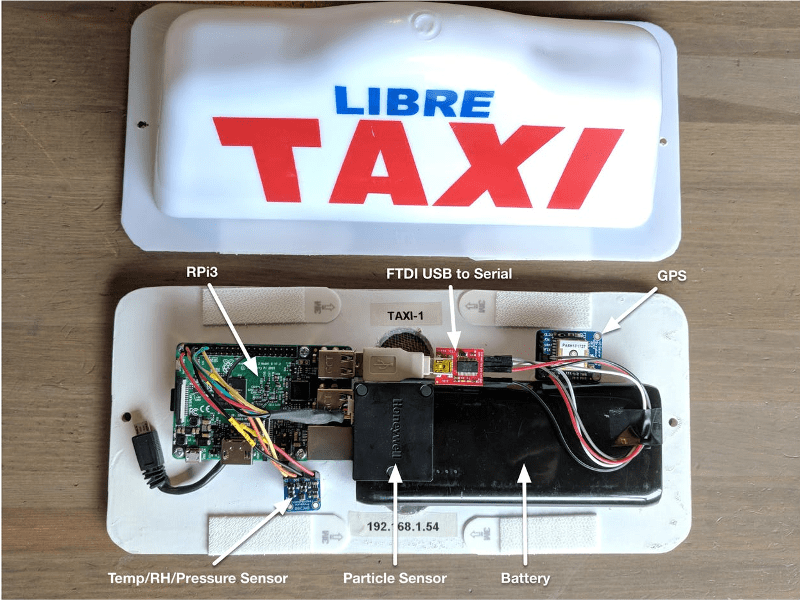When [James] moved to Lima, Peru, he brought his jogging habit with him. His morning jaunts to the coast involve crossing a few busy streets that are often occupied by old, smoke-belching diesel trucks. [James] noticed that his throat would tickle a bit when he got back home. A recent study linking air pollution to dementia risk made him wonder how cities could monitor air quality on a street-by-street basis, rather than relying on a few scattered stations. Lima has a lot of taxis, so why wire them up with sensors and monitor the air quality in real-time?
 This taxi data logger’s chief purpose is collect airborne particulate counts and illustrate the pollution level with a Google Maps overlay. [James] used a light-scattering particle sensor and a Raspi 3 to send the data to the cloud via Android Things. Since the Pi only has one native UART, [James] used it for the particle sensor and connected the data-heavy GPS module through an FTDI serial adapter. There’s also a GPS to locate the cab and a temperature/humidity/pressure sensor to get a fuller environmental picture.
This taxi data logger’s chief purpose is collect airborne particulate counts and illustrate the pollution level with a Google Maps overlay. [James] used a light-scattering particle sensor and a Raspi 3 to send the data to the cloud via Android Things. Since the Pi only has one native UART, [James] used it for the particle sensor and connected the data-heavy GPS module through an FTDI serial adapter. There’s also a GPS to locate the cab and a temperature/humidity/pressure sensor to get a fuller environmental picture.
Take a ride past the break to go on the walk through, and stick around for the testing video if you want to drive around Lima for a bit. Interested in monitoring your own personal air quality? Here’s a DIY version that uses a dust sensor.
















Citizen science is fun. For a real challenge wire birds up to tell you what the air environment is.
Hahaha….or is it? I wonder how much tech you could pack in a leg tag. What’s the max range on powering a passive RFID component? Hmm.
Hmmm didn’t we hear that SD cards had been abused to run code the other day, would presume microSD poss? Need power though.
What do pigeons really want though? How do you motivate their behaviour to your advantage… ???
Got it! We’ll 3D print fake Dickin medals!
What a gas!
Excuse my puns. It would seem to be simpler to me to design dedicated hardware (gps, wifi, sensor readings) or use quite generic hardware. (an android phone with an FTDI friend) Depending on the use-case (cheap & easy in small batches vs cheap and easy in large baches) the Pi falls in the strange middle ground between the two. The Pi is great for prototyping, it’s not so great for final products. Can’t wait to see where this is going and what directions it is taken!
As a prototype then, the pi seems fine.
And since you just need to plug the wires at the right place and do some sudo apt-get,
it can be done in an afternoon.
Proof of concept would be better than prototype
Or we could boycott FTDI and use alternatives from more agreeable companies.
Won’t the fact it’s in the vicinity of a tail pipe at all times invalidate the readings?
I might question the accuracy of a pollution sensor which is bolted to a running internal combustion engine.
I think this thing of hanging everything on diesel only is a bit silly and unrealistic, old diesel might be more polluting, but more is not the same as only.
To measure impact on runners, attach said device to runner.